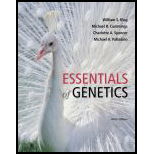
Concept explainers
CASE STUDY | Links to autism
As parents of an autistic child, a couple decided that entering a research study would not only educate them about their son's condition, but also help further research into this complex, behaviorally defined disorder. In an interview, researchers explained to the parents that autism results from the action of hundreds of genes and that no single gene accounts for more than a small percentage of cases. Recent studies have identified 18 genes that have a higher likelihood of involvement, referred to as candidate genes; three of these, on chromosomes 2, 7, and 14, are regarded as very strong candidate genes. Generally unaware of the principles of basic genetics, the couple asked a number of interesting questions. If you were the interviewer, how would you respond to them?
How might identification of a “candidate” gene be helpful in treating autism?
To analyze:
The query of the parents of an autistic child, about the risk of having second child autistic, as the genetic condition depends on several factors.
Introduction:
Autism is the disease that is a result of the action of hundreds of genes. Almost 18 genes are known to be most likely involved in it, that are referred to as “candidate” gene. Out of 18 genes, three genes are present on chromosome number 2, 7, and 14, which are regarded as a strong candidate gene.
Explanation of Solution
Autism is a neurodevelopmental disorder that affects the individual’s ability to interact with people. It occurs at very early stage in childhood. Autism has a genetic basis, even though the genetics of the autism is complex.
Selection of candidate gene can be helpful in treating the autism. The researchers can locate the gene and can isolate the mutation. The treatment regimens can be developed by the researchers to treat the mutation, by targeting those specific mutations. Gene knockout and gene knock-in can be used through either the mutated genes are deleted from the organism or in place of the defected gene new gene is inserted, for its normal function.
Neuroligin 3 is a cell adhesion protein that functions to connect the brain cells to each other. Mutation in the neuroligin 3, that leads to the change in 451 amino acid from arginine to cystine. It is the genetic change associated with autism. This change can be corrected by targeting the gene and so the identification of the gene can be helpful in treating the autism.
As this genetic disorder is controlled by a number of genes, researchers suggest that there is a higher probability of autism in second child also, as the siblings share similarity with respect to their genetic structure.
Therefore, it can be concluded that identification of the candidate gene can be helpful in treating the autism, and there is a higher probability of autism in second child if the first one is autistic.
Want to see more full solutions like this?
Chapter 7 Solutions
Essentials of Genetics (9th Edition) - Standalone book
- Explain how the hormones of the glands listed below travel around the body to target organs and tissues : Pituitary gland Hypothalamus Thyroid Parathyroid Adrenal Pineal Pancreas(islets of langerhans) Gonads (testes and ovaries) Placentaarrow_forwardWhat are the functions of the hormones produced in the glands listed below: Pituitary gland Hypothalamus Thyroid Parathyroid Adrenal Pineal Pancreas(islets of langerhans) Gonads (testes and ovaries) Placentaarrow_forwardDescribe the hormones produced in the glands listed below: Pituitary gland Hypothalamus Thyroid Parathyroid Adrenal Pineal Pancreas(islets of langerhans) Gonads (testes and ovaries) Placentaarrow_forward
- Please help me calculate drug dosage from the following information: Patient weight: 35 pounds, so 15.9 kilograms (got this by dividing 35 pounds by 2.2 kilograms) Drug dose: 0.05mg/kg Drug concentration: 2mg/mLarrow_forwardA 25-year-old woman presents to the emergency department with a 2-day history of fever, chills, severe headache, and confusion. She recently returned from a trip to sub-Saharan Africa, where she did not take malaria prophylaxis. On examination, she is febrile (39.8°C/103.6°F) and hypotensive. Laboratory studies reveal hemoglobin of 8.0 g/dL, platelet count of 50,000/μL, and evidence of hemoglobinuria. A peripheral blood smear shows ring forms and banana-shaped gametocytes. Which of the following Plasmodium species is most likely responsible for her severe symptoms? A. Plasmodium vivax B. Plasmodium ovale C. Plasmodium malariae D. Plasmodium falciparumarrow_forwardStandard Concentration (caffeine) mg/L Absorbance Reading 10 0.322 20 0.697 40 1.535 60 2.520 80 3.100arrow_forward
- please draw in the answers, thank youarrow_forwarda. On this first grid, assume that the DNA and RNA templates are read left to right. DNA DNA mRNA codon tRNA anticodon polypeptide _strand strand C с A T G A U G C A TRP b. Now do this AGAIN assuming that the DNA and RNA templates are read right to left. DNA DNA strand strand C mRNA codon tRNA anticodon polypeptide 0 A T G A U G с A TRParrow_forwardplease answer all question below with the following answer choice, thank you!arrow_forward
 Human Heredity: Principles and Issues (MindTap Co...BiologyISBN:9781305251052Author:Michael CummingsPublisher:Cengage Learning
Human Heredity: Principles and Issues (MindTap Co...BiologyISBN:9781305251052Author:Michael CummingsPublisher:Cengage Learning Biology: The Dynamic Science (MindTap Course List)BiologyISBN:9781305389892Author:Peter J. Russell, Paul E. Hertz, Beverly McMillanPublisher:Cengage Learning
Biology: The Dynamic Science (MindTap Course List)BiologyISBN:9781305389892Author:Peter J. Russell, Paul E. Hertz, Beverly McMillanPublisher:Cengage Learning Biology Today and Tomorrow without Physiology (Mi...BiologyISBN:9781305117396Author:Cecie Starr, Christine Evers, Lisa StarrPublisher:Cengage Learning
Biology Today and Tomorrow without Physiology (Mi...BiologyISBN:9781305117396Author:Cecie Starr, Christine Evers, Lisa StarrPublisher:Cengage Learning Concepts of BiologyBiologyISBN:9781938168116Author:Samantha Fowler, Rebecca Roush, James WisePublisher:OpenStax College
Concepts of BiologyBiologyISBN:9781938168116Author:Samantha Fowler, Rebecca Roush, James WisePublisher:OpenStax College Biology: The Unity and Diversity of Life (MindTap...BiologyISBN:9781305073951Author:Cecie Starr, Ralph Taggart, Christine Evers, Lisa StarrPublisher:Cengage Learning
Biology: The Unity and Diversity of Life (MindTap...BiologyISBN:9781305073951Author:Cecie Starr, Ralph Taggart, Christine Evers, Lisa StarrPublisher:Cengage Learning Biology (MindTap Course List)BiologyISBN:9781337392938Author:Eldra Solomon, Charles Martin, Diana W. Martin, Linda R. BergPublisher:Cengage Learning
Biology (MindTap Course List)BiologyISBN:9781337392938Author:Eldra Solomon, Charles Martin, Diana W. Martin, Linda R. BergPublisher:Cengage Learning





